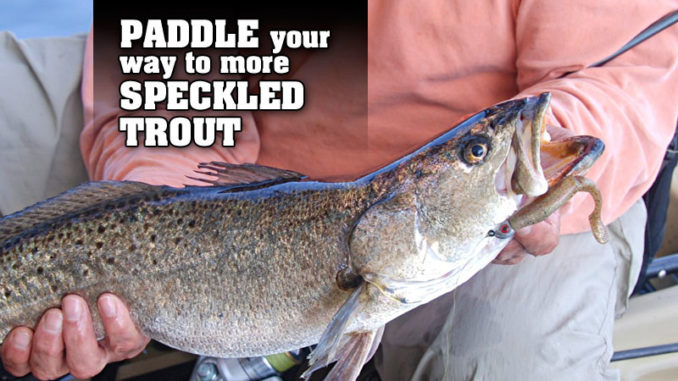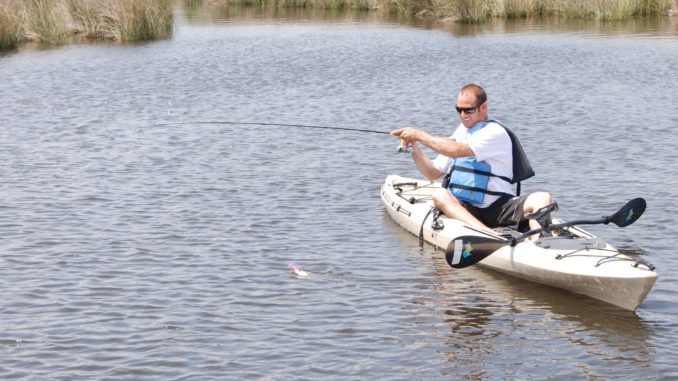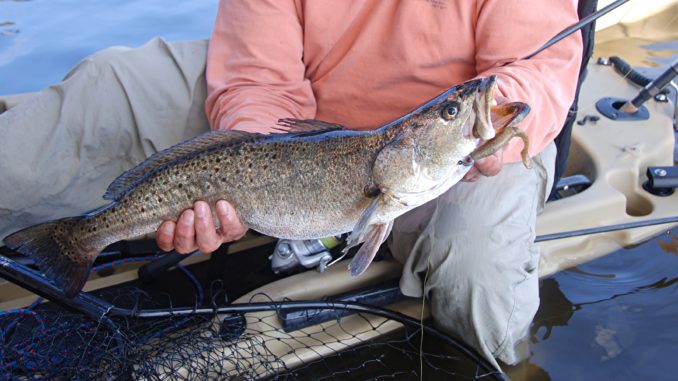
Trout give kayak anglers a great fall target
Since January, we’ve covered strategies, rigging and tactics for targeting different species from a paddle craft. Along the way, we’ve covered saltwater, freshwater and even delved into some hunting. Noticeably absent on this list was a favorite saltwater species along the entire Carolina coast: speckled trout.
For kayak anglers, targeting speckled trout falls into three main categories: trolling, casting artificial baits and drifting live baits.
Trolling is a tested tactic starting in mid-September and tapering off by December.
One of the big differences between fishing in the two Carolinas is that North Carolina has a lot of backwater creeks that get very little tidal flow, while almost every creek in South Carolina rises and falls at least 5 feet every cycle. Essentially, that limits trolling for trout in South Carolina to the top and bottom of the tide cycle as water movement comes to a standstill. Trolling can be productive through the tide cycle in most parts of North Carolina.
When trolling for speckled trout, target the backs of creeks and creek channels edges where trout move in to feed. Troll multiple, soft-plastic baits in varying color schemes on different sized jigheads to find a color and size preferences. The idea is to key in on the jighead size and color of the bait that fish prefer. If you make a pass through a likely area without strikes, move to another location.

Kayak trolling speeds are somewhere in the 1 to 2½ mph range, which can be measured on a sonar/GPS unit or just by watching the creek bank go past. Speed will vary slightly with paddle or pedal strokes; no one ever said that was a bad thing.
In October, target trout holding in fairly shallow water, most of the time less than 6 feet deep. Many kayak anglers believe trolling for specks gives them an advantage over stationary bait fishing or casting because of the number of baits presented in the strike zone.
To rig for trolling, you’ll need two, four or even six rod holders arranged so that lines don’t tangle. Varying rod lengths from longest to shortest will help with this also.
Casting artificial baits, usually a grub or shrimp on a jighead, is probably the most-popular tactic when kayak-fishing for trout. Anglers also catch plenty of trout on topwater plugs early in the morning, late in the evening or during low-light conditions.
Popping corks are a kayak angler’s best friend when trying to fish shallow structure from an anchored position. A boat rigged with a deployable anchor, stakeout pole or shallow-water anchor system allows an angler to position slightly upstream of structure, cast parallel to the structure and bring the bait back through the strike zone.
Speckled trout will move to shallow water early and late in the day during the fall. As sight-feeders, trout shy away from bright light during the middle of the day but will roam the shallows in low-light conditions. Topwater and subsurface crank baits and plugs are good choices in low-light conditions.

Target structure such as grass points, oyster bars and man-made cover in the mid depths. Mid-depth ranges for speckled trout around structure range from 4 to 10 feet. At those depths, an angler with a decent sonar unit can graph fish holding along mid-range dropoffs, anchor up or drift, and present soft plastics on a jighead or other weighted baits.
As September rolls into October, trout tend to move from their grass-hugging ways out into the current a little more, especially when mullet, shrimp and other baitfish begin moving toward inlets.
By using live bait, a slower, more-natural presentation is possible by casting to likely fish-holding structure; let the bait flow go with the flow and just let the current just bounce the bait along. With cooling water and air temperatures, a decent flow-troll bucket tethered to the boat will hold plenty of live bait. Letting your kayak and bait move with the current can be deadly, and the size of the kayak tends not to spook fish like a power boat can.
The best live baits for speckled trout are going to be those that match the hatch. In October, shrimp are king, with finger mullet running a close second. Fan-casting live bait under a popping cork will help locate schools of trout.
Good locations to search for trout when using live bait are at creek and ditch mouths or the end of a long oyster rake where a tide rip has been established. Cast the bait to either side of the rip and let it drift with the current, popping the cork vigorously to gain the fish’s attention.
A kayak angler can target multiple rips on a falling tide by beaching the boat at or near the end of a rip and making casts both up and down current.




Be the first to comment